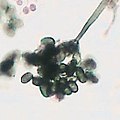Conidiomata (singular: Conidioma) are blister-like fruiting structures produced by a specific type of fungus called a coelomycete. They are formed as...
3 KB (405 words) - 23:30, 6 December 2023
of these structures is called a conidioma (plural: conidiomata). Two important types of conidiomata, distinguished by their form, are: pycnidia (singular:...
15 KB (1,778 words) - 03:21, 25 May 2025
lichenicolous fungi faced significant challenges in distinguishing between the conidiomata of the lichen mycobiont and those of lichenicolous fungi. David L. Hawksworth...
69 KB (7,354 words) - 08:58, 30 March 2025
Coelomycetes if they produced their conidia in minute flask- or saucer-shaped conidiomata, known technically as pycnidia and acervuli. The Hyphomycetes were those...
56 KB (6,822 words) - 19:51, 3 April 2025
undetermined. The asexual morph features conidiomata, the fruiting structures of coelomycetes. The conidiomata are black when dry, dark brown when moist...
3 KB (296 words) - 21:57, 26 May 2025
(muriform), and have thin septa and walls. There is no known formation of conidiomata, asexual reproductive structures, in this family. This is a list of the...
9 KB (691 words) - 00:29, 13 February 2025
the sexual reproductive structures typically found in other fungi. The conidiomata, which are asexual reproductive structures, are typically more or less...
5 KB (533 words) - 01:53, 25 April 2024
characterized by asexual morphs with mononematous to sporodochial to synnematous conidiomata, usually with phialidic conidiogenous cells that produce 0–1-septate...
7 KB (597 words) - 04:03, 9 December 2024
fungus forms singular, immersed to semi-immersed fruiting bodies known as conidiomata, which are black, subglobose (nearly spherical), and measure 180–250 μm...
5 KB (577 words) - 03:33, 11 December 2024
secondarily perforated at the bottom. They usually produce numerous conidiomata along their margins and, later, apothecia or hymenial disks. Scyphi may...
4 KB (413 words) - 23:13, 6 March 2025
Cyclaneusma is an ascomycete it produces two spore types, an asexual (conidiomata) and sexual (ascomycota) spore. Controlling Cyclaneusma has presented...
13 KB (1,759 words) - 19:10, 18 August 2024
all share the features of having sporodochial (cushion-shaped masses) conidiomata which is semi-macronematous to macronematous (having a morphologically...
17 KB (1,380 words) - 02:49, 3 June 2025
distribution. Species of this genus are usually observed producing zone lines, conidiomata and ascomata on dead fallen leaves, but at least some are known to colonize...
7 KB (586 words) - 16:23, 15 May 2024
are pycnothyria (conidiomata) with radiating setae-like hyphae that form along the necrotic veins. In spring, black crustose conidiomata (pychnothyria)...
9 KB (1,126 words) - 02:16, 3 May 2025
irregularly. Conidiomata are red, with irregularly shaped and convoluted compartments. There is a single opening (ostiole) on top of the conidiomata that is...
6 KB (646 words) - 00:59, 13 April 2025
formation of fruiting structures called sporodochia, which are open conidiomata in the form of tufts of conidiophores on the thallus. Although these...
12 KB (1,156 words) - 17:21, 19 July 2024
(supporting tissue) is thick and hard, surrounding a narrow central canal. The conidiomata (asexual reproductive structures) form at the tips of the podetia, appearing...
4 KB (434 words) - 03:30, 1 April 2025
vacuolar body, with eight spores per ascus. Another reproductive feature, conidiomata (pycnidia), are usually found immersed in the thallus and produce spores...
13 KB (1,256 words) - 14:34, 2 October 2024
lichen forms irregular patches or clumps and includes numerous false conidiomata, a type of asexual reproductive structure, within its thallus. Its lobes...
5 KB (559 words) - 22:51, 18 May 2024
outer layer. In some species, other reproductive structures, known as conidiomata, are present and often have a rough surface. As of May 2025[update],...
13 KB (1,125 words) - 00:23, 28 May 2025
The genus is characterized both by its black convex sporodochia-like conidiomata, as well as the well-differentiated exciple on these structures. The...
11 KB (827 words) - 04:15, 9 February 2025
have a thin gelatinous coating. Asexual reproductive structures called conidiomata have not been observed to occur in this genus. Schizotrema flavolucens...
7 KB (570 words) - 00:56, 11 December 2024
Gnomoniopsis Morphology of Gnomoniopsis chinensis from PDA, a colonies on PDA b conidiomata formed on PDA c, f conidia d, e conidiogenous cells. Scale bars: 1 mm...
1 KB (59 words) - 15:05, 5 January 2024
simple or have a single septum. Protocandelariella does not usually have conidiomata (structures that bear conidia). Instead, the underside of the squamules...
9 KB (685 words) - 20:33, 19 May 2025
characterized by its vividly coloured apothecia and unique, campylidioid conidiomata. Badimia multiseptata was first described by lichenologists Khwanruan...
7 KB (410 words) - 15:56, 28 February 2025
brown, 1-septate to somewhat muriform, distoseptate, and non-amyloid. Conidiomata have not been observed in Nadvornikia lichens. The secondary chemistry...
5 KB (449 words) - 19:59, 1 October 2023
chemical features, though mature reproductive structures (ascomata and conidiomata) were not observed in the type specimen. The species was described during...
5 KB (543 words) - 22:50, 1 February 2025
lumina are rectangular and slightly rounded, but not diamond-shaped. Conidiomata, or structures that produce conidia (asexual spores), are rather rare...
12 KB (997 words) - 10:13, 5 January 2024
or smooth, often with irregular cracks and small papillae containing conidiomata, but lacking isidia and soredia. Its apothecia (fruiting bodies) are...
10 KB (740 words) - 00:00, 27 December 2024
It is characterised by ostiolate pycnidial (asexual fruiting body) conidiomata, annellidic conidiogenous cells, the absence of conidiophores, and brown...
10 KB (869 words) - 01:19, 14 May 2024

















